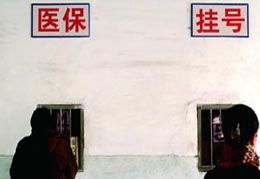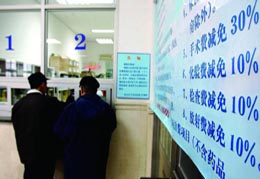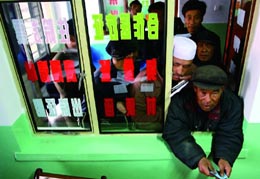Case Studies in Chinese Health Care Reform
After two years of deliberation, the draft of China's health care reform was finally released for public scrutiny on October 14. The reform aimed to provide universal health care for all rural and urban Chinese in the future, and to quell increased complaints over rising medical costs.
However, the draft drew a swarm of criticism from industry players. The EO holds that it is much more meaningful and helpful to explore the local reform experience rather than be limited to theoretical debates. With that in mind, the EO explored local health care reform schemes around China.
Want Want Hospital: can it be repeated? At Want Want Hospital in Hunan province, there are soft-matted benches instead of hard plastic chairs. The X-ray department is near both orthopaedics and the heart-lung treatment center. A $3 million electronic patient management system helps patients quickly review their health conditions and bills.
At Want Want Hospital in Hunan province, there are soft-matted benches instead of hard plastic chairs. The X-ray department is near both orthopaedics and the heart-lung treatment center. A $3 million electronic patient management system helps patients quickly review their health conditions and bills.
Backed by Taiwanese food company Want Want Group, Want Want Hospital was China's first large-scale private joint-venture hospital,
After two years of growth, the hospital has seen outpatients volume reach some 1,000 per day. Patients are spending less money at this private hospital than they would at a public ones due to its fewer follow-up visits and fewer days in hospital.
Want Want's road has not been smooth, however.
The hospital registered as a profitable medical institution in order to avoid local government's strict control, but the downside of this status was higher taxes and utilities fees.
For example, Want Want paid taxes on subsidies it received to treat patients during the Sichuan earthquake.
In addition, patients enjoy less reimbursement credit here than at public hospitals despite that it is a licensed medical institution under the local basic medical insurance system.
The hospital initially suffered discriminatory treatment by the local and reputable Xiangya Hospital School of Medicine. If doctors left Xiangya to join Want Want, relatives still working at Xiangya must also quit their jobs.
Zheng Wenxian, executive president of Want Want Hospital, suggested, "The best way push public hospitals [to improve services] is to enable fair competition. The reality is, on the one hand the government welcomes your investment, on the other hand, it sets up many hoops for you.
Despite this, his hospital has brought about some impacts to local medical environment and some hospitals had renovated their buildings, he added.
Original article: [Chinese]
Wu Hu: Independent Drug Sales When Su Yuanyuan, director of Wuhu Medical institution Drug Administration Center, sat down with the EO for a three-hour interview, his cell phone didn't ring once.
When Su Yuanyuan, director of Wuhu Medical institution Drug Administration Center, sat down with the EO for a three-hour interview, his cell phone didn't ring once.
Su's agency was established earlier this year. Normally, he would be swamped with calls by drug peddlers, but he is idle now.
Su told the EO that this is because medical treatment in Wu Hu had recently been separated from drug sales, and the drug administration center's power was decentralized.
Earlier this year, in order to root out corruption, the Wuhu municipal government of Anhui Province took over all pharmacies and staff at its eight public hospitals and set up an independent drug administration center to manage all drug sales.
In this way, drug sale revenues were handed over in entirety to the municipal government, which would in turn allocate budgets. The government returned a portion of the drug revenues in the name of financial subsidies to the hospitals.
To prevent corruption at the center, its power structure was divided into three parts: decision-making, implementation, and supervision.
One source at a large drug company told the EO that the reform hadn't affected his job at all, and that he still paid doctors who used his drugs as usual.
Some opponents have pointed out that the reform didn't fundamentally eradicate "conflict of interest chain" within the country's drug supply, which went from pharmaceutical factory to drug dealer, to doctors and pharmacies, and lastly to patients.
Original article: [Chinese]
Establish a Medical Service Community Two community health service centers in Beijing together with Peking University People's Hospital were testing a pilot referral model between community-based health services and hospitals.
Two community health service centers in Beijing together with Peking University People's Hospital were testing a pilot referral model between community-based health services and hospitals.
Poor allocation of treatment and lagging development in health services at the community level, have resulted in larger hospitals were over-burdened with patients.
The pilot enabled patients to get treatment at either of two community health service centers. Doctors would use the internet to reserve medical departments at Peking University People's Hospital, and arrange referrals according to patients' conditions.
With the reservation, patients could get treatment in Peking University People's Hospital without queuing. After their checkup, their treatment regimes would be sent back to the community health service center, where patients could buy medicine at lower prices.
This experiment was launched in September and promoted by Wang Bin, president of Peking University People's Hospital. He said the purpose was to leverage the advantages of both community health service centers and big hospitals. In this way, larger hospitals could focus on treating serious illnesses while community health service centers could cure more common aliments.
Original article: [Chinese]
Ningjin: Worries about the Rural Health Care Network Ningjin county in eastern Shandong province has long embraced the rural cooperative health care system, which covered over 80% of Chinese farmers in 2004. Under the system, farmers receive a certain percentage of reimbursement for their medical expenses from a special health care fund to which both farmers and the government contribute.
Ningjin county in eastern Shandong province has long embraced the rural cooperative health care system, which covered over 80% of Chinese farmers in 2004. Under the system, farmers receive a certain percentage of reimbursement for their medical expenses from a special health care fund to which both farmers and the government contribute.
As its name suggests, the system is based on cooperation among farmers. However, this sense of cooperation has been diluted by stronger government support as China has put emphasis on improving its social security network in recent years.
During the past four years, the yearly premium for farmers in Ningjin remained at 10 yuan, while the government subsidy for each farmer has risen from 10 to 60 yuan. Among the 60 yuan, 14 yuan comes from the Ningjin county government,and the rest from government departments are higher levels.
But as a result, fiscal pressure on the local government has increased dramatically. With poor financial revenue and some 380,000 farmers under the system, the Ningjin government spent 2.7% of its total revenue on cooperative healthcare.
But despite the recent injection of funding, the system suffers from having too few participating medical institutions and a lack of administrative personnel.
Ningjin's cooperative healthcare fund in totaled 27.1 million yuan in 2008, and managing it required an eight-person team. The Ningjin Cooperative Healthcare Office was responsible for registration participants, verifying identities, reimbursement, and inspecting fraud. Such a team would be too small for simply investigating fraud, said the office's deputy director.
Of the 856 villages in Ningjin, only 22 have medial institutions that provide services covered by the network.
Original article: [Chinese]
The views posted here belong to the commentor, and are not representative of the Economic Observer |
Related Stories
Popular
Briefs
- OPhones to Take on iPhone
- The 3G-enabled Lenovo Mobile OPhone is likely to provide stiff competition to Apple's iPhone in the China market.

- Source:China Mobile
- 6.4-Magnitude Quake Rocks West China
- A 6.4-magnitude earthquake struck China's western Qinghai province earlier this morning.
- Source:China Earthquake Networks Center

- TAX
- Taxing Times
- China's tax bureau aims to collect an additional 100 billion in tax before the end of the ...




















